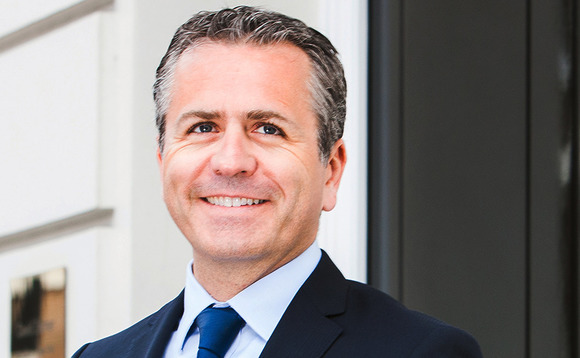
Prime-time for secondaries

The private equity secondaries market has continued to deliver record transaction volumes over the past five years. But can this relatively nascent segment absorb ever-mounting levels of dry powder? Alice Murray and Katharina Semke report
Looking back over the past 18 months, dedicated secondaries funds have clearly been a popular choice for institutional investors. In the large-cap market alone, Lexington Capital Partners raised $10.1bn for its eighth vehicle; Coller Capital collected $7.1bn for its Fund VII; Partners Group raised €2.5bn for its 2015 fund; and, most recently, Ardian closed its latest dedicated offering on $10.8bn. According to Benoît Verbrugghe (pictured), member of the executive committee and head of Ardian's US operations, demand for the fund was oversubscribed by around $3-4bn.
While investor demand for secondaries appears to be in abundance, results from a survey conducted by Cebile Capital at the beginning of the year highlight growing concerns towards future activity. Respondents expected a drop in deal volumes due to volatility seen at the end of 2015 and the beginning of this year. Furthermore, given the favourable fundraising conditions, competition, particularly at the larger end of the market, is likely to be fierce, with newly raised vehicles upping already high levels of dry powder, currently estimated to be in the region of $65bn.
The deal hunter
Against this backdrop, Ted Craig, partner and head of secondaries at law firm MJ Hudson, says: "The challenge for big funds is the size of deals needed to deploy recent amounts raised."
The Cebile report finds the market bifurcated between large players able to transact more than $1bn, all of which completed more than 10 deals in 2015, while those deploying smaller amounts all did fewer than 10 deals.
All of the conversations we were having, especially with buyers, were around volatility in the equity markets, which was making them hesitant to do deals" – Ted Craig, MJ Hudson
While larger players have clearly been investing at a faster pace, there are questions emerging as to how long this can continue. Many have pointed out that current dry powder levels simply represent a year or two of typical secondary deal volumes (which have come in at around $40bn for the past few years) and, given funds typically have a four- to five-year lifespan, this should not present a great concern. However, Marco Wulff, partner and co-founder of Montana Capital Partners, points out that "lots of these funds have displayed a much quicker investment pace. More funds have been investing quickly over the past four or five years in general."
Ardian's Verbrugghe, however, notes that "there are only two to four players who can quickly underwrite these deals and have the ability to execute. This is important because the seller must be comfortable."
However, as the Cebile survey shows, volatility experienced over the past six months or so is starting to bite. "There was a lull in the beginning of the year," says Craig. "All of the conversations we were having, especially with buyers, were around volatility in the equity markets, which was making them hesitant to do deals." While Craig's team was busy in Q1, he says that was because they were closing deals that had been in processes in 2015, where buyers and sellers had already agreed pricing and terms. "We might see fewer deals in Q2. That gap caused by the hesitancy in Q1 will come through and could even spread into Q3," he says.
Rolling in the deep
Given the potential deal lag caused by volatility, is there any more depth in the secondaries market? Commentators frequently point to the fall off in regulatory-driven sales, so has anyone stepped in to take their place?
Ardian's Verbrugghe has noted some compelling trends in relation to sellers. According to Ardian research, sovereign wealth funds accounted for 34% of sales in 2014-2015, with pension funds representing 23% of sellers in the same period. This marks a dramatic change to the make-up of sellers in 2009-2010 where banks were dominant – accounting for 58%, which has since slipped to 17%. "Banks have reduced their proportion, so we can see that switch, that evolution. Now we can see that private equity is a mature market, which needs liquidity," says Verbrugghe.
Furthermore, Verbrugghe is confident on how the market will progress, believing there to be far more potential sellers. "In the US, each state has four or five pensions funds, meaning this is a very deep and sustainable market. In the US, Ardian targets around 700 sellers, representing $881bn in private equity – around 80% of the market – and this is only in the US. In Europe there are more than 400 investors representing $500bn of private equity where there is always the potential for selling or the requirement for liquidity. And there is potential for more sellers, which is what we've been seeing in the past 12 months."
Verbrugghe's positivity on the further depths of the market is neatly reflected by current deal pipelines. "There are lots of deals out there at the moment," says Craig. "The challenge is for buyer and seller to agree on pricing. But people are feeling more confident now from speaking to buyers, sellers and advisers. We're already seeing a pick up."
For Verbrugghe, the market can absolutely absorb current levels of dry powder. "Buyers are more or less the same people that have been there over the past 10 years. Most of us have increased our fund sizes, but each time only by 20-25%. But there are still only 15-20 players globally, so increasing fund sizes simply follows the evolution in the market."
Coller Capital investment principal Giovanni Orsi, echoes this sentiment: "Transaction volumes were at record levels in 2014 and 2015, and the market expects a high level of transactions in 2016 as well. Our pipeline confirms that; we're still seeing large fund books. So all the signs are in place for transaction volumes to stay in line."
Verbrugghe says Ardian currently has a number of deals in its pipeline, many of which exceed $1bn: "Of course we will be selective, but this highlights that, within our current pipeline, there are $18bn's worth of deals – and that's just Ardian. And none of these are GP restructurings."
Rising restructurings
It is somewhat surprising that Ardian has so far never invested in a GP restructuring, given these types of deals are on the rise. "There have been more GP restructurings, from mid- to large-size transactions," says Montana's Wulff. "These have mainly been driven by portfolios taking lots of time and which need more time before they can make meaningful distributions. For LPs that have been invested in a fund for more than 10-12 years, they're often wanting to get out. We will increasingly see more of these because there are so many portfolios taking longer to be returned than expected."
A notable restructuring to have taken place recently was that of TDR Capital. In February, the GP launched an annex fund to inject fresh cash into older investments held in an existing vehicle. For Craig, this marks an interesting market development: "In the past it has mainly been struggling managers that have needed to restructure. The TDR vehicle shows the development of fund restructuring. In time, we'll see more well-regarded, well-performing managers leading restructurings, as a means of giving their LPs some liquidity before the fund is returned. In the US, we're already seeing credible managers doing some sort of recap."
Coller's Orsi is upbeat towards the new source of dealflow: "There is a large opportunity for restructuring private equity funds. In 2014, there were around $5bn of GP restructurings, out of $40bn of total volume, and that figure increased in 2015. Furthermore, it is expected to rise to $10bn in 2016. Looking at our pipeline so far, especially in the US, that trend is being confirmed."
Despite this, Ardian is reluctant to participate. "Today we are one of the exceptions; we haven't done any GP restructurings," says Verbrugghe. "We're often not comfortable with the quality of assets and potentially the team as well. But we will never say never – it is a big part of the market after all."
Given the concerns surrounding the quality of GP restructurings, for Orsi, selectivity is key: "You need to be mindful about the quality of assets; you need to be selective. And for us it's important to understand what the current investor base thinks about the managers. We need to be careful we are not doing too much work without knowing if there is a significant number of sellers among the LP base."
Orsi also points out that, given Coller's size, the firm is more likely to see opportunities in the US than in Europe: "For us, deals in the US are typically larger because there are lots of US mid-market funds in the $1-2bn AUM range, so it's interesting from a secondaries point of view. Looking at the European market, fund sizes are generally smaller and so the opportunity is smaller. We have turned down three or four of these deals because they were too small."
However, there is a similar transaction that Ardian is far keener on. Says Verbrugghe: "We prefer ‘tender processes' – this is where, for example, the GP is investing fund six but still has fund three – this is a way of returning investment to LPs. And, today, there are some very strong GPs that want to speak to us for tender offers with very specific prices to offer their LPs liquidity options. For these deals, we can be an interesting buyer. So these aren't restructures – it's a tender offer, in order to provide liquidity to LPs in older funds. These sales can create $4-5bn of deals and this market is growing."
New entrants
While GP-led restructurings and tender processes are on the rise, there are also new sources of dealflow coming from new players. Says MJ Hudson's Craig: "We're working on sell sides for family offices. We are starting to see them selling purely strategically, where they are not under any pressure to sell. They had been advised on how much they could get for their stakes, selected those they were happy with and went ahead with the deal."
Beyond family offices increasingly using the secondaries market in a more opportunistic manner, Verbrugghe expects to see endowments coming to market: "The opportunity there is big, though not necessarily on transaction size, as they would probably be selling around $300-500m each time."
He also notes that there are still US banks with private equity exposure, which could result in multi-billion dollar deals. Furthermore, despite post-crash regulation inflicting tight restrictions on the amounts banks can invest in private equity funds, Verbrugghe believes banks will return as important players in the secondaries market: "Banks are investing in private equity again, albeit at a lower level, but they will need to sell again to stay within their core ratio levels, so this is another way of feeding the secondaries market."
While on the surface, more players looking to sell into the secondaries market seems positive; but, in reality, the impact could be less so. Cebile managing partner Sunaina Sinha notes the impact of varying return expectations on pricing: "A non-traditional buyer such as a family office or pension plan buyer that has a lower return target – say 8% – will be able to pay more because they only want that 8% return and can live with that higher price. Most secondaries buyers are usually trying to target a 12-15% return."
Maturing, not just aging
Despite potential pressure on pricing, the emergence of new players points to the increasing maturity of secondaries.
This market was borne out of the need for banks and insurance funds to decrease their exposure to private equity in the wake of the financial crisis, and for other institutional investors seeking ways out of troubled funds. The market has come a long way over recent years. "Sellers are not stressed and they are certainly not distressed," says Sinha. "They don't have to sell unless they get what is to them an attractive price."
Indeed, the rise of active portfolio management by LPs shows the secondaries market evolving into an asset class in its own right. "In one recent case, an institution had a $40m stake in a big-name fund," says Craig. "Normally the sale encompasses the entire stake, but in this case the seller only wanted to sell a portion and retain the rest, highlighting a current need for active portfolio management."
For many years, secondaries were generalists, but you are starting to see groups that specialise in particular areas. I predict that we will get more specialisation over time as the market becomes more competitive" – Joe Marks, Capital Dynamics
Furthermore, the market is becoming more sophisticated in how it generates returns, highlighted by an almost ubiquitous use of leverage. According to Sinha, around 15% of secondary deals comprise explicit leverage, while more than 70% employ some sort of implicit leverage, such as deferred payments.
Another sign of maturity is an increasingly standardised approach used throughout the market. "For our segment, the instruments that have been used in the larger end of the market, such as deferred payments and structured transactions, we are also using at the smaller end. We're seeing sellers open to using structured transactions for deals in the €30-80m range, not only in the €500m-plus segment," says Montana's Wulff.
And a predicted rise in specialised funds also highlights the growing sophistication of the secondaries market, as players seek to mitigate rising prices and competition by focusing on certain niches.
Says Joe Marks, managing director and head of secondaries at Capital Dynamics: "For many years, secondaries were generalists, but you are starting to see groups that specialise in particular areas. I predict that we will get more specialisation over time as the market becomes more competitive."
Alongside funds focusing on certain sectors, for Ardian's Verbrugghe, there are more defined sectors of assets being traded, including infrastructure and real estate: "We're seeing more opportunities here. Infrastructure has developed over the past 10 years, and lots of LPs have exposure, but these funds typically have lifespans of 20 years, so now is a good time to be selling these interests. In the energy sector, given the evolution of this market, there will be more opportunities – especially as this market is more reactionary." And when it comes to real estate, Verbrugghe points to Calpers' sale of real estate interests worth $2bn's last year, noting more of these deals are coming to market.
Orsi agrees: "The market is evolving. Over the past four or five years, we've started to see more secondary transactions in real estate and debt. Energy is starting to develop, too, and these will be important themes for 2016."
Slowdown to speed up
The current outlook for secondaries is largely positive, thanks to new entrants, yet-untapped sellers, increasing sophistication, the emergence of specialised players and new sectors up for grabs. But the picture is not entirely rosy. "Buyers should be taking into account a potential slowing economic environment," warns Marks. "That does not mean it will fall off a cliff, it just means we have enjoyed a very big run since the bottom of the market, so the chances are it can't continue at the pace we have seen over the past five or six years."
When the markets are volatile, and there is a correction in the market, it forces a decision and accelerates the process. So potential volatility can be positive. But you need to be selective and avoid a big decrease" – Benoît Verbrugghe, Ardian
Wulff has a similar outlook: "There may be a correction but we don't know when, so we spend lots of time on the downside. We would rather give up some of the return and be safe. We don't know if the market will hold up over the next two years."
Verbrugghe agrees: "I am positive, but also very cautious – I am expecting a slowdown."
While a market correction may suspend deals when it hits, in the meantime, the expectation of a slowdown appears to be causing the opposite effect. "As a buyer, in terms of dealflow opportunities, volatility can be good because normally most transactions, or potential transactions, can take between one and two years," says Verbrugghe. "When the markets are volatile, and there is a correction in the market, it forces a decision and accelerates the process. So potential volatility can be positive. But you need to be selective and avoid a big decrease."
While secondaries players are sitting on large piles of dry powder, this is only a reflection of investor demand for this increasingly mature and sophisticated market. And there seems little doubt that transaction volumes for 2016 will be on track or higher than previous years thanks to a growing number of sellers and a move towards specialisation. What is less clear is the stability of pricing – more opportunistic players could push pricing higher and, in turn, returns lower. But until the next downturn hits, secondaries funds in all parts of the market will be busily putting their dry powder to work.
Latest News
Stonehage Fleming raises USD 130m for largest fund to date, eyes 2024 programme
Sponsor acquired the public software group in July 2017 via the same-year vintage Partners Group Global Value 2017
Stonehage Fleming raises USD 130m for largest fund to date, eyes 2024 programme
Czech Republic-headquartered family office is targeting DACH and CEE region deals
Stonehage Fleming raises USD 130m for largest fund to date, eyes 2024 programme
Ex-Rocket Internet leader Bettina Curtze joins Swiss VC firm as partner and CFO
Stonehage Fleming raises USD 130m for largest fund to date, eyes 2024 programme
Estonia-registered VC could bolster LP base with fresh capital from funds-of-funds or pension funds









